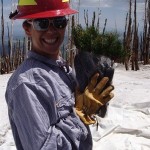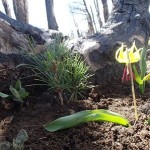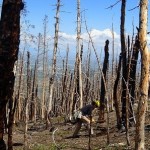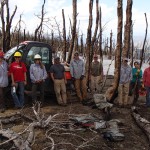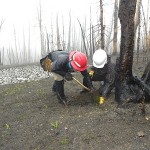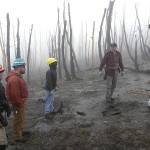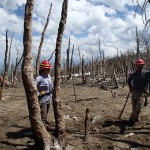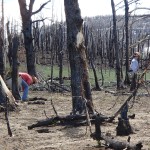2014 WBP Planting in Pony Fire
Project: WBP Planting in Pony Fire – Beaverhead-Deerlodge National Forest and BLM-Dillon Field Office 2013
Agency/Forest or Park/District: Beaverhead-Deerlodge National Forest and BLM-Dillon Field Office
Project coordinator: Rob Gump (USFS); Emily Guiberson (BLM)
Contact: Rob Gump (rgump@fs.fed.us), 420 Barrett St., Dillon, MT, 406-683-3965; Emily Guiberson (eguibers@blm.gov), 1005 Selway Dr., Dillon, MT 59725, 406-683-8005
Cooperators: Beaverhead-Deerlodge National Forest and BLM-Dillon Field Office
Source of funding/amount FHP: $7,500 of supplemental funding provided; $15,000 from FS and BLM (salaries, purchase of seedlings, and equipment for road opening and planting). Whitebark Pine restoration funds were used to pay for the seedlings at the Coeur d’Alene Nursery. The other $5,000 was used to cover the costs of getting into the site to plant. A local contractor was used to plow the road open to facilitate earlier planting.
Dates of restoration efforts: Planting completed by June 2014
Objectives: Restoration of area burned in the 2012 Pony Fire to enhance regeneration and reduce competing vegetation. This area is a high priority for restoration as identified in the Whitebark Pine Strategy (GYCC 2011). Restoration utilized 5,000 existing seedlings from the Bridger-Teton NF that were suitable to transfer within the GYA to this site in the Tobacco Mountains, MT (Mahalovich 2012).
Acres/ha treated: 26 acres (16 on USFS, 10 on BLM lands) were planted in the area of the Pony Fire in the Tobacco Root Mountains (Greater Yellowstone Ecosystem)
Methods: The road was successfully opened the last week of May 2014 to allow for planting the following week. The project was completed over a 4-day period during the first week of June 2014. Forestry and non-forestry staff from within both agencies were utilized. This Interagency coordinated project proved to be a great learning experience for both agencies. Due to the little planting experience on the BLM’s part, the USFS stepped up to teach and assist with planting this site on both sides of the fence. There was a later site visit where agency managers as well as partners (GYCC and American Forests) and volunteers were able to come see what the project accomplished.
Planting? If so, source of seedlings? Resistance? A total of 5,300 excess seedlings from the Bridger-Teton NF were planted. The seed source was previously screened for resistance.
Outcome: Because of this coordinated effort, both agencies have been able to restore these 26 acres of public lands. The site has been given an advantage and a jump start to getting back the whitebark pine site that burned in the 2012 Pony Fire.
Monitoring since completion of the project: Follow-up monitoring was conducted; post-planting exams showed 100% seedling survival rates. Of the 300 seedlings that were planted in June 2013, we estimate 99% survival through the first year.
Dates:
Plans for future monitoring?
Will outcome meet goals? Yes
Future actions/follow up:
Miscellaneous comments: This project was done with staff from both agencies, rather than by contract. The small amount of planting that the two offices did this previous spring gave an indication that completing the planting in June 2014 with Forest and BLM staff would not be easy due to the physical demands of the work. The two project leaders ensured that enough competent staff, both in experience and physical ability, were available, and also ensured that enough days were set aside to ensure high quality planting took place.
